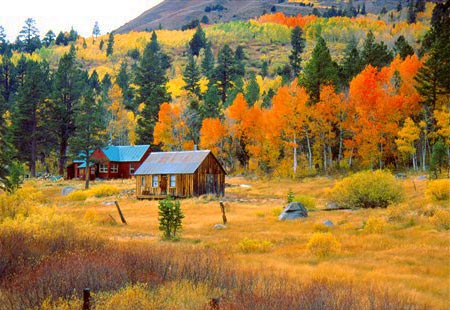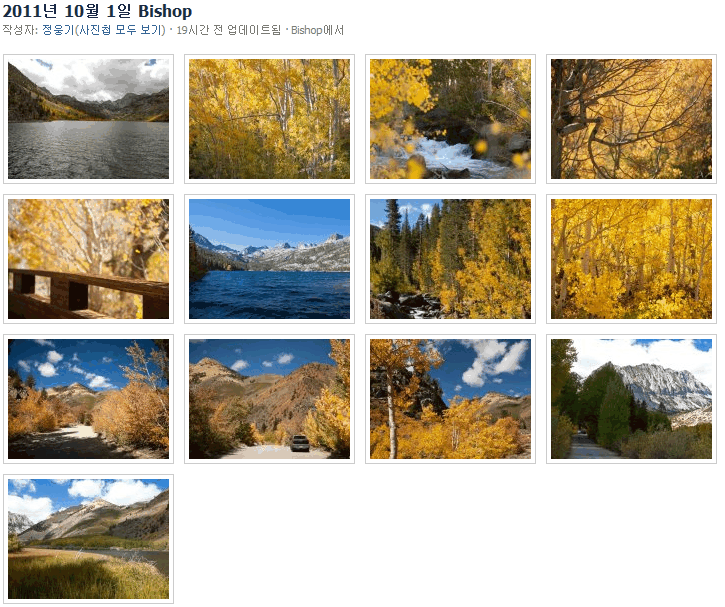왜 매년 가을이 오면 나뭇잎이 빨강, 주홍, 자주, 노란색으로 에쁘게 물이 들까요 ?
그이유는 화학적 변화 때문 입니다.
봄과 여름철에 나뭇잎은 크로로삘 ( Chlorophyll ) 이 들어 있는 세포속에서 영양분을 만들어
나무가 쑥쑥 자랄수 있도록 도와주는 공장 역활을 합니다.
나뭇잎은 태양 에너지를 흡수 해서 공기중에 있는 이산화 탄소와 뿌리에서 빨아 들인 물을 합성 시켜
나무가 성장 하는데 꼭 필요한 탄수화물, 즉 전분과 당분으로 전환 시킴니다.
크로로삘은 초록색 색소 입니다.
나뭇잎에는 초록색 색소 뿐만 아니라 Xanthophyll (노란색) 과 Carotenes 색소 (노랑, 주홍, 빨강 ) 도 함께 있지만
초록색이 압도적으로 많아, 봄과 여름철에는 나뭇잎이 온통 초록색 으로만 보입니다.
그러나 여름철이 끝나고 가을철이 되면, 기온이 내려가고 낮이 짧아지면서
나뭇잎은 영양분을 만드는 과정을 중단 합니다. 그로인해 크로로삘은 분해되어
초록색 색소는 점점 사라져 버리고 주홍, 빨강, 노란색 색소만 남아,
울긋 불긋한 나뭇잎으로 가을을 화려하게 장식 합니다.
또 다른 화학 반응으로 빨간 색소인 앤토싸야닌 ( Anthocyanin ) 도 만들어 집니다.
나뭇잎은 따뜻한 낮에 당분을 만드나 , 추운 밤에는 잎속에 있는 당분을 움직이지 못하게 잡아 놓읍니다. 이때 빨간 색이 만들어 집니다.
Dogwood 나 Sumac 은 빨간색과 자주색 으로, Sugar Maple 은 빨간색과 노란색을 섞어 만든 주황색으로,
Oak 잎은 좀 남아있는 크로로삘은 다른 색소들을 섞어서 주홍 밤색으로 우아하게 치장을 합니다.
단풍색과 단풍 기간은 기온, 일사량, 수분에 아주 민감 합니다.
영상을 약간 웃도는 밤기온 (섭씨 7도) 은 빨간 색소인 앤토싸야닌을 만드는데 유리합니다.
단풍나무의 아주 유별나게 밝고 따뜻한 빨간색은 따듯한 햇볓이 있는 낮과 차가운 밤이 계속 교차 될때에만 만들어 집니다.
그러나 서리가 너무 일찍오거나, 따뜻한 밤기온, 흐리거나 비가오는 날이 계속되면 덜예쁜 붉은색이 되어 버립니다.
http://www.fs.fed.us/fallcolors/2012/science.shtml
모든 나무가 단풍이 드는것은 아닙니다. 그리고 단풍 기간은 오래 가지 않으므로 적절한 시기를 잘 맟추어서 보러 가야 합니다.
미국 동부나 위스콘신주, 미네쏘타주 에서는 초록색 Cedar 와 어울려 노랑 Aspen, 빨간 Maple 로 울긋불긋한 화려한 단풍을 볼 수 있습니다.
캘리포니아주에서는 한국의 설악산 단풍과는 격이 다르지만 노란색 단풍을 몇 군데에서 보실수 있읍니다.
레이크 타호 남쪽이나, 근처 하이웨이 89 번에 있는 호프 발리 (Hope Valley) 에서 Aspen 의 노란색 단풍을 보실수 있읍니다.
그리고 Eastern Sierra 에 있는 하이웨이 395 번을 따라서도 여러군데에서 노란 애스펜의 장관을 구경 할수 있읍니다.
아래는 캘라포니아주의 단풍을 추적하는 핫라인 입니다.


 일전에 산행 중에 찍은 사진인데, 무엇일까요?
일전에 산행 중에 찍은 사진인데, 무엇일까요?
 Garmin GPSMAP 62ST 질렀습니다.
Garmin GPSMAP 62ST 질렀습니다.


Fall Color
There are several fine viewing areas near the Town of Mammoth Lakes. Check out the Sherwin Creek Campground area by following
The
TheMammoth Lakes Scenic Loop . The scenic loop road intersects Hwy. 203 as it winds to Mammoth Mountain Ski Area, and brings you out on Hwy.395 about 5 miles north of Mammoth Lakes. An easy side trip to Inyo Craters, just off the loop road, offers a great place for a picnic lunch.
Devils Postpile National Monument , Rainbow Falls and the San Joaquin River
The Reds Meadow area,
20 miles north of
This incredibly beautiful drive is a treat any time of year, but fall colors make this route especially pretty. Follow Hwy 395 north to the south junction of Hwy 158. The road winds past the community of
Lee Vining CanyonTioga Pass and the eastern entrance to Yosemite National Park
35 miles north of Mammoth Lakes
Take Hwy 395 to the Tioga Pass/Yosemite National Park turnoff Hwy 120, climbs through a steep canyon, affording incredible views of the rugged landscape and the canyon's fall colors. It you continue on Hwy 120, you'll reach
Lundy Canyon
45 miles north of Mammoth Lakes
Lundy Canyon and Lundy Lake are reached by driving north on Hwy 395 past Lee Vining and Mono Lake. Just before you begin the ascent over Conway Summit you'll see the turnoff (Hwy 167). The short drive leads to one of the most beautiful settings in the Eastern Sierra.
Continue north on Hwy 395 past the turnoff to
Convict LakeMammoth Lakes Convict Lake
10 miles south of
12 miles south of
While you can observe some fall color from your vehicle,
20 miles south of
Rock Creek is a beautiful, glacier-carved canyon, just off Hwy 395 at Tom's Place. Continue up Rock Creek Canyon 9 miles to